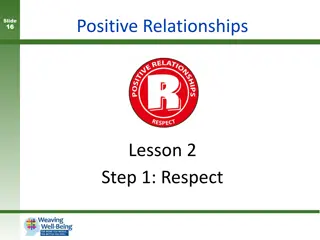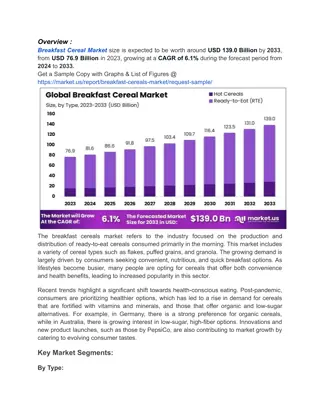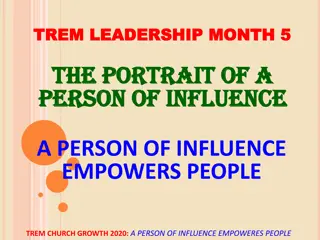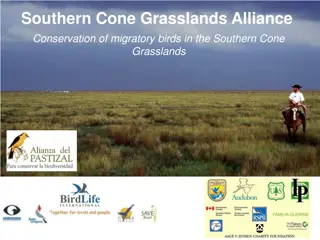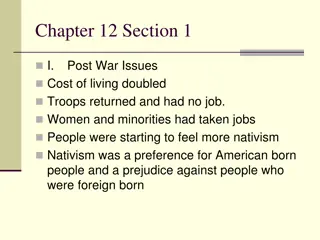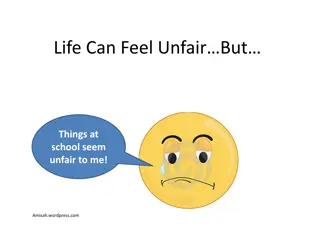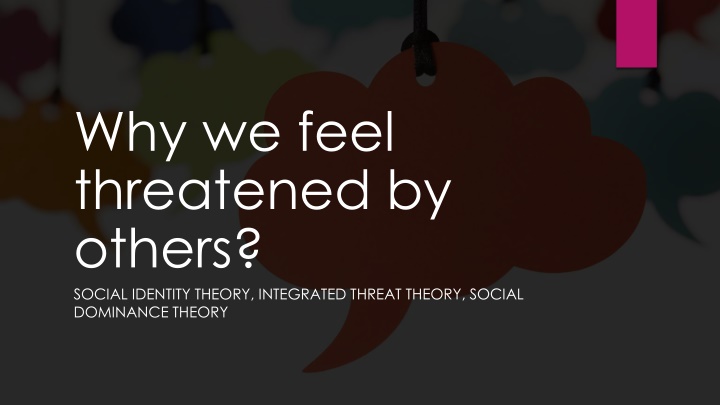
Threat Perceptions and Group Dynamics in Social Identity Theory
Explore why individuals feel threatened by others through the lens of Social Identity Theory, Integrated Threat Theory, and Social Dominance Theory. Learn how social categorization, identification, and comparison shape group dynamics, leading to ingroup favoritism and outgroup derogation. Discover the impact of stereotypes, prejudices, and discriminatory attitudes on intergroup relations.
Download Presentation

Please find below an Image/Link to download the presentation.
The content on the website is provided AS IS for your information and personal use only. It may not be sold, licensed, or shared on other websites without obtaining consent from the author. If you encounter any issues during the download, it is possible that the publisher has removed the file from their server.
You are allowed to download the files provided on this website for personal or commercial use, subject to the condition that they are used lawfully. All files are the property of their respective owners.
The content on the website is provided AS IS for your information and personal use only. It may not be sold, licensed, or shared on other websites without obtaining consent from the author.
E N D
Presentation Transcript
Why we feel threatened by others? SOCIAL IDENTITY THEORY, INTEGRATED THREAT THEORY, SOCIAL DOMINANCE THEORY
Social Identity theory (Tajfel, 1970) Suggests that our identity and self esteem depends on social groups Sense of Belonging Group membership leads to 2 concepts: o Ingroup people within our social group o Outgroup people outside our social group or other groups A) Social categorization B) Social identification C) Social comparison 3 Components: We feel that our groups are better and more deserving than other groups; o Ingroup favoritism o Outgroup derogation
Experiment Hartely, 1946; American students from 8 different universities had to react toward 35 ethnic groups A distance scale was used; How close you are willing to accept (to marry him) or to reject person (not allow in a country) 3 (of 35) groups were fictitious: Danerians, Pirenians, Wallenians The majority rejected them People have no problem discriminating against groups that they do not know, and that sometimes do not even exist
Ingroup and Outgroup formation HTTPS://M.YOUTUBE.COM/WATCH?V=GA4ZR7P25O 0
Process of social categorization begins early in childhood Self categorization as a member of a group leads to formation of judgments and stereotypes reflecting this group identity Holding stereotype often leads to prejudicial and discriminatory attitudes and behavior Current Intergroup research Becoming a member of a group has potentially adaptive dimensions; individuals take care of others within the group Individuals may be rejected from the group for reasons that have to do with group membership (gender, race, ethnicity) not as a function of behavioral traits and individual differences Hierarchical relationships between cultures are often maintained by conventions and stereotypic expectations, which often perpetuate power and status relationships
Identity theory applied on immigrants Identification with one s own country is related to derogation of immigrants Nationalism Patriotism Similar to Ethnocentrism National identification and Adherence to democratic values One s own group is the center of things Democratic norms decrease outgroup devaluation Belief in national superiority and dominance Seems to reduce negative sentiment toward immigrants but any kind of national I-G I can be misused (War against terrorism) Is measured with reference to other countries Native-born citizens who are highly identified with their national ingroup a who perceive immigrants as a threat should be biased against immigrants
Integrated threat theory Based in : Reaslistic Conflict theory(Sherif, 1967) Intergroup hostility can arise as a result of conflicting goals and competition over limited resources Group position theory (Blumer, 1950, Bobo, 1999) the larger the size of an outgroup, the more the corresponding ingroup perceives it to threaten its own interests Intergroup threats and fears are the major causes of prejudice and discrimination Sources of threats: a) Economic power -> realistic threats b) Different values -> symbolic threats c) Anxious, tense -> intergroup anxiety d) Lazy, Untrustworthy -> negative stereotypes
Social dominance theory Contemprorary human societies are organized as group biased hierarchies Integrates conceptual insights from different levels of analysis (evolutionary, psychological, sociological) Group-based inequalities are maintained through three primary mechanisms: a) institutional discrimination b) individual discrimination c) behavioral assymetry Many different prejudices may result from the tendency to justify and maintain the unfair outcomes associated with dominant versus subordinate social categories
Link between prejudicial statements on immigrant and theories Statements about immigrants Theoretical explonation Immigrants take our jobs. Ingroup favouritism Immigrants are not as us and never be! Outgroup denigration Immigrants take advantage of our social system. Stereotypic expectation Immigrants are lazy and can t be trusted. Realistic threat Their culture and religious beliefs are incompatible with ours! Symbolic threat Dominant group bias Unlike them (immigrants), we work hard
How do British accept others? Cleavlend, 2013




